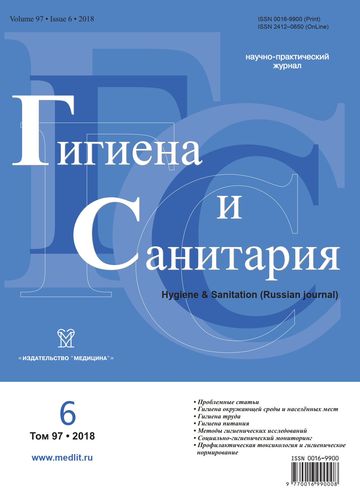Assessment of biological influence of chloroquinoline derivative
- Authors: Epishina T.M.1
-
Affiliations:
- F.F. Erisman Federal Scientific Center of Hygiene of the Federal Service for Surveillance on Consumer Rights Protection and Human Wellbeing
- Issue: Vol 97, No 6 (2018)
- Pages: 505-508
- Section: ENVIRONMENTAL HYGIENE
- Published: 20.10.2020
- URL: https://ruspoj.com/0016-9900/article/view/640328
- DOI: https://doi.org/10.47470/0016-9900-2018-97-6-505-508
- ID: 640328
Cite item
Full Text
Abstract
Introduction. The antidote of chloroquinoline derivative contains in the stuff of selective, post-emergence herbicide of systemic action against a broad spectrum of annual cereals weeds for one-time ground handings of spring and winter weed crops. Cultural cereals are protected by the presence of the antidote chlorhinoline derivative in the preparation.
The aim of the study. To investigate the exploring chronic influence of the antidote chloroquinoline derivative in its multiple entering warm-blooded organisms (male rats) for finding out the kind of the biological influence, active and non-active doses, were conducted.
Material and methods. White rats were used in the acute experiments (6 animals per group). Doses of 1000-7000 mg/kg were tested. The chronic experiment was executed on 80 rats. Doses of 0.4; 4.0 and 40 mg/kg were tested. The estimation of the animals behavior, food, and water consumption, terms of animals death was fixed, alterations in body weight, physiological, biochemical and hematological indices were registered in the experiment were conducted.
Results. The evaluation of general behavior of animals received antidote in dose of 40.0 mg/kg gave such a result as the deviation in such indices as behavior responses and SPP, analysis of hematological and biochemical tests showed the alteration in lipid and lipoprotein metabolism; aminoalkyl metabolism; anaerobic glycolic to take place in animals’organisms.
Conclusion. Indices of the acute peroral toxicity of antidote LD50 in male rats, peroral: 4349 ± 840 mg/kg b.w. hazard class — 4 according to hygienic pesticide classification on hazard class (SanPin 1.2.2584-10) were established. 2. Active 40,0 mg/kg and non-active (NOELch) 4,0 mg/kg the dose was established. 3. The admissible day dose (ADD) for a human of 0.04 mg/kg b.w. was justified.
About the authors
Tatiana M. Epishina
F.F. Erisman Federal Scientific Center of Hygiene of the Federal Service for Surveillance on Consumer Rights Protection and Human Wellbeing
Author for correspondence.
Email: pesticidi@yandex.ru
ORCID iD: 0000-0003-0331-0701
MD, Ph.D., DSci., senior researcher of the Department of toxicology and environmental hygiene of the F.F. Erisman Federal Scientific Center of Hygiene of the Federal Service for Surveillance on Consumer Rights Protection and Human Wellbeing, 141014, Mytischi, Russian Federation.
e-mail: pesticidi@yandex.ru
Russian FederationReferences
- Rakitskii V.N. Hygienic principles and criteria of pesticide danger (risk) assessment. In: Collection of Studies: Hygienic Aspects of Environment and Public Health Protection. Sbornik nauchnykh trudov: Gigienicheskie aspekty okhrany okruzhayushchry sredy I zdoron’ya naseleniya. Moscow; 1999. (in Russian)
- Govermmental catalogue of pesticides and agrochemicals allowed for usage in Russian Federation. Moscow; 2015. (in Russian)
- Sinitskaya T.A., Malinovskaya H.H. Toxicological-hygienic justification of the acceptable daily intake of acetamiprid. М. Gigiena and sanitarya. 2016; 95(11): 1055-8.
- Methodical instruction on hygienic assessment of new pesticides. Kiev. 1988: 210.
- Handbook on pesticides. Red. Medved P.I. Kiev. Yrozai; 1977: 375.
- Kagan Y.S. General pesticide toxicology. Kiev. Zdorovie; 1981: 176.
- Rylova M.L. Method of exploring chronic action of adverse environment factors in the experiment. L., Medicine; 1964: 227.
- Pavlenko S.M. Application of summation-threshold index in toxicological experiment on white rats. Methodic of sanitary-toxicological experiment: scientific works collections of MNIIG named after F.F. Erisman. M.; 1975: 5-7.
- Methodical recommendation on using reaction of animals’ behaviour in toxicological researches for hygienic standardization. Kiev; 1980: 47.
- Anokhin P.K. Surveys on functional systems physiology. M.: Medicine; 1975: 448.
- Notkin E.L. Statistics and hygienic researches. М.; 1986: 965.
- Prozorovskiy V.B. The least sguares method usage for probit analysis of lethality curves. Farmakologiya i toksikologiya. 1962; (1): 111-9. (in Russian)
- Laboratory methods of clinical researches: Handbook. Menshikov V.V., Delektorskaya L.N., Zolotnitskaya R.P. and others; Menshikov V.V. ed. М.: Medicine; 1987: 368.
- Clinical biochemistry: Manual for laboratory doctors. Kalb V.G., Kamyshnikov V.S. Minsk, Byelorussia. 1976; 311.
- Potapov A.I., Rakitskiy V.N. et al. Hygienic pesticide qualification on hazard class (MR №2001/26 of 16.04.2001).
- State catalog of pesticides and agrochemicals, which are permitted to be used on the RF territory. М.; 2003: 115.
- C.D.S. Tomlin, ed. The Pesticide Manual. 16-th edition. Alton: BCРС; 2012: 1139.
- Handbook on pesticides. Pavlov A.V. К. ed. Yrozai; 1986: 432.
- Melnikov N.N., Novozilov K.V., Belan S.R. Pesticides and regulators of plants growths. Handbook. М. Chemistry; 1995: 575.
- Rakitskiy V.N. New hygienic pesticide classification.The plants protection. М. 2000; №3. 6p
- Federal sanitary rules, norms and hygienic normatives. Hygienic normatives of pesticide presence in environmental objects (list). HN 1.2.3111-13. Moscow; 2013: 23.
- A. Potapov, V. Rakitski, N. Nikolaeva New Russian toxicological-hygienic classification of pesticides. Toxicology Letters – September 2005; 158 (1): 136.
- Zhiryakov V.G. Organic chemistry. М.: Chemistry; 1974: 186.
- Zlenko E.G., Desichenko E.M., Homyak N.V. Ж. Pharmacology and toxicology. Kiev: «Health»; 1990: 234.
- Kulikova N.A., Lebedeva G.F. Herbicides and environmental aspects of their use: Tutorial. M: LIBROKOM, 2010: 152 (in Russian)
- Version 1, 2 (December 26, 2016). Directory of pesticides and agrochemicals allowed for use in the temitory of the Russian Federation. M.: AGRORUS; 2016: 218. (in Russian)
- Pesticide Chemistry. Crop protection, Public health, Environmental safety. Ed.by Ohkawaa H., Miyagawa H., Lee P.W. Verlang. WILEY-VCH; 2007: 497.
- The Pesticide Manual. 16-th edition. 2012.
- Berezovskaya I.V., Rymartsev V.I., Volkova L.I., Borisova L.N., Zuzya Yu.R. Preclinical study of general toxic action of Ethoxydole. М: «Toxicological bulletin»; 2012: 42-5.
- GN 1.2.3.111 – Hygienic standards for pesticide content in environmental facilties (list): Hygienic standards: M: Federal Center for Hygiene and Epidemiology of Rospotrebnadzor; 2014: 131. (in Russian)
Supplementary files









